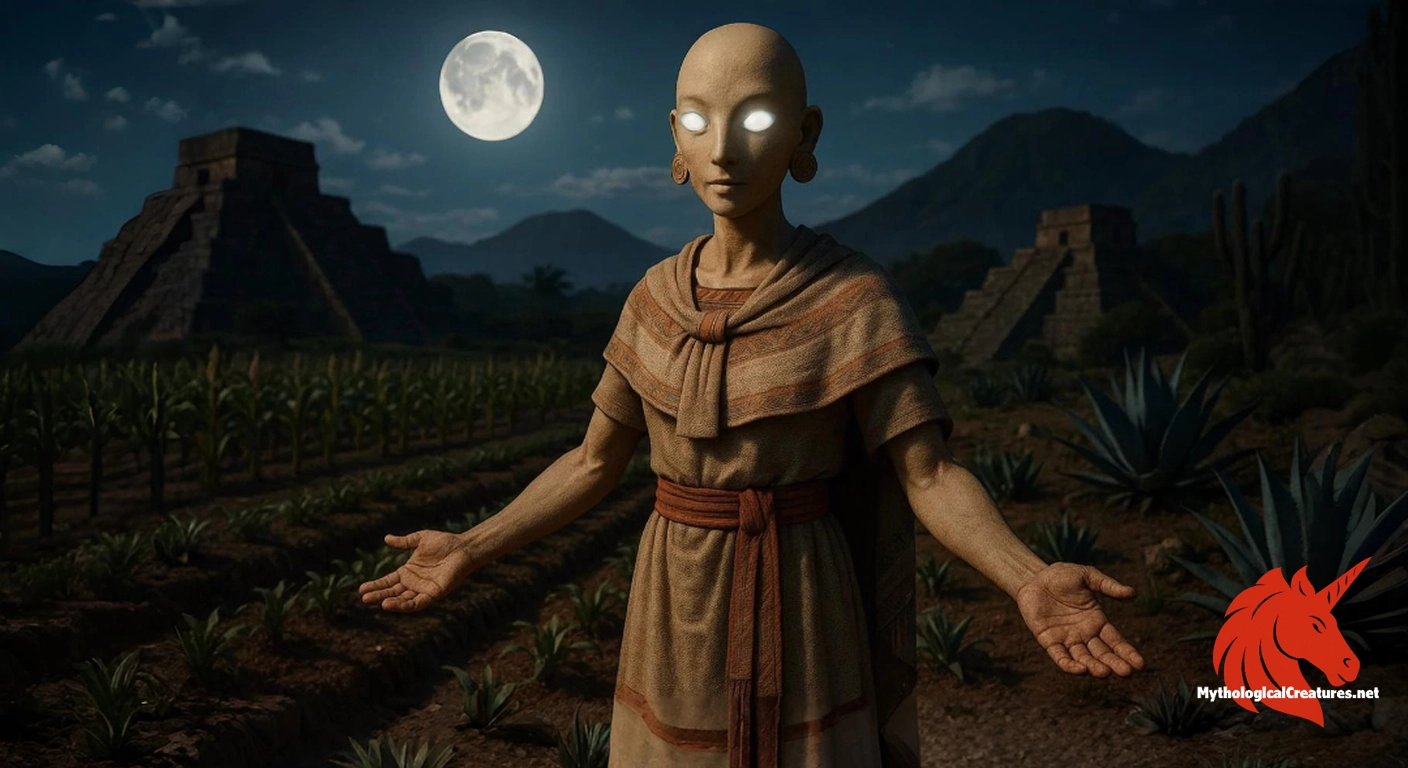Metztli: Metztli is a lunar deity from Aztec mythology, revered as the god or goddess of the moon, night, and agricultural fertility.

Metztli
Metztli - Metztli symbolizes the cyclical nature of time and fertility, playing a key role in agricultural success and the regulation of night.
Origins & First Encounters
Metztli occupies a unique place in Aztec mythology as a deity intricately linked to the mysteries of the moon, the quiet of the night, and the rhythms of agricultural life.
Emerging from a tradition that venerates celestial bodies, Metztli is woven into the tapestry of indigenous cosmology, where the phases of the moon symbolise both change and continuity.
The deity’s name, derived from the Nahuatl word for moon, immediately connects it to cycles that govern both nature and society.
Metztli is portrayed in some traditions with a fluid identity, embracing aspects that are both masculine and feminine, thereby reflecting the inherent duality of lunar phenomena.
Early attestation of this celestial figure can be traced to codices and oral traditions, which highlight its essential role in marking time and agricultural cycles.
The cultural context in which Metztli was revered was one where the night was not merely a period of darkness, but a space of transformation and regeneration.
Its significance extended beyond the celestial, serving as a divine intermediary between the natural world and the agricultural pursuits vital to Aztec society.
Ritual ceremonies celebrated the waxing and waning of the moon as manifestations of divine power, ensuring that the deity was deeply integrated into everyday life.
This amalgamation of astronomical, natural, and human elements makes Metztli an enduring symbol of balance and renewal.
Source Texts & Tale Variants
Historical records and indigenous codices serve as the primary sources through which Metztli is known, revealing a blend of visual art and succinct narrative fragments.
Tales associated with this deity appear in several pre-Columbian manuscripts that depict the intricate cycles of the moon and their impact on agricultural practices.
Some variants of the myth portray Metztli as the luminous overseer of the night, casting its gentle light upon the earth and guiding the rhythms of planting and harvest.
Other story versions incorporate elements of cosmic duality, where the deity’s presence is seen as both a harbinger of growth and a keeper of night’s mysteries.
Visual depictions in surviving codices illustrate Metztli with symbols that underscore its celestial attributes, such as crescent shapes and radiant patterns.
Oral traditions passed down through generations have further enriched the narrative, suggesting that the deity’s influence extended into everyday rituals and seasonal observances.
In certain accounts, the narrative of Metztli intertwines with broader cosmological events, hinting at an elaborate mythology concerned with the interplay between light and darkness.
Fragments from early colonial texts, though sometimes filtered through a European lens, hint at the multifaceted and sometimes ambiguous roles attributed to the deity.
These varying sources, despite their fragmentary nature, collectively build a picture of a deity who was both essential and enigmatic in the Aztec mythos.
Form & Powers
Artistic representations of Metztli often depict the deity with an ethereal quality that merges human features with celestial symbolism.
Images in codices frequently present a face marked by the subtle interplay of light and shadow, echoing the gentle glow of the moon in the night sky.
The deity is sometimes illustrated with luminescent eyes and a countenance that suggests both serenity and an underlying dynamism.
Adornments typical of lunar imagery, such as crescent motifs and star-like embellishments, are recurrent in depictions of Metztli, reinforcing its cosmic identity.
Some portrayals blend anthropomorphic characteristics with abstract elements, such as swirling patterns and delicate lines that evoke the phases of the moon.
In many images, soft silver hues dominate the palette, imbuing the deity with a sense of otherworldly radiance.
The physical form of Metztli is intermittently interlaced with symbols derived from agriculture, including motifs reminiscent of maize and natural harvest icons.
These visual details highlight the dual realms that the deity inhabits—the celestial sphere and the terrestrial world of fertility.
Though artistic interpretations can vary, the consistent focus on lunar imagery and gentle, flowing forms underscores the central significance of the moon in the deity’s identity.
This fusion of human and celestial elements creates a rich, layered portrayal that has captivated artists and devotees alike.
Regional Faces
Across the diverse landscapes of Mesoamerica, the figure of Metztli has been subject to various local reinterpretations that mirror the unique traditions of each region.
In the heartland of the Aztec empire, the deity’s association with the cycles of agriculture and the nocturnal sky has been firmly established through ritualistic practice and detailed iconography.
Neighbouring cultures, while sharing the reverence for the lunar phases, have sometimes merged Metztli with their indigenous moon deities, resulting in overlapping mythologies.
In northern regions, for example, local adaptations have emphasised the nurturing and protective aspects of the deity, often highlighting a more distinctly feminine persona.
Parts of Central Mexico, meanwhile, maintain a dual-gendered interpretation that allows Metztli to embody both the gentle and the fierce qualities of the night.
Villages and local priesthoods have preserved unique ceremonial practices that honour the deity’s multifaceted nature, blending broader Aztec traditions with local symbolism.
Some regional codices depict the deity with subtle variances in attire and ornamentation, reflecting the distinct artistic sensibilities of their communities.
These variations underscore the adaptability of Metztli’s myth, showing how a central divine figure can evolve to reflect local environmental and cultural conditions.
Ultimately, the regional diversity in the portrayal of Metztli highlights a broader Mesoamerican tendency to blend cosmic phenomena with everyday life.
Cultural Parallels
The celestial and agrarian functions of Metztli invite comparisons with lunar deities from other mythological traditions, forming a rich dialogue between disparate cultural narratives.
In Greek mythology, for instance, Selene personifies the moon with an elegance that echoes Metztli’s own dual nature, merging celestial mystery with human influence.
Roman traditions similarly celebrate Luna, whose depictions often reference the light that governs nocturnal life, paralleling the Aztec reverence for the moon’s cyclical power.
Indian mythology offers the figure of Chandra, whose shifting phases symbolise the changing tides of nature, resonating with the themes of renewal present in Metztli’s lore.
Across these diverse mythologies, the interplay between light and darkness, growth and decay, emerges as a common motif that underscores the universal importance of the lunar cycle.
Metztli’s incorporation of agricultural elements further distinguishes it, as the deity seamlessly integrates the natural cycles of fertility with the cosmic patterns of the night sky.
This hybrid role finds echoes in other traditions where lunar deities are also guardians of agricultural rites, illustrating a deeply rooted human connection with the cosmos.
The merging of celestial attributes with earthly responsibilities in these various myths demonstrates a shared human desire to understand and celebrate natural cycles.
Comparative analyses not only highlight similarities in iconographic motifs, but also reveal a common symbolic language that transcends geographical and cultural boundaries.
Such cross-cultural insights enrich our understanding of how societies conceptualise celestial figures like Metztli as both divine beacons and stewards of the land.
Legacy & Modern Evolution
Over the centuries, the interpretation of Metztli has undergone significant transformation, reflecting shifts in cultural and religious sensibilities.
In pre-colonial times, the deity was integrally linked to the agricultural calendar, with communities looking to the moon as a guide for planting and harvest rituals.
The onset of colonialism brought profound changes, as European influences sought to recast indigenous beliefs within a new religious framework, sometimes obscuring the traditional significance of Metztli.
Nevertheless, the underlying power of the deity endured in the memories of local communities, where oral traditions kept its legacy vibrant and relevant.
In recent decades, there has been a robust revival of interest in pre-Columbian mythologies, with Metztli emerging as a potent symbol of indigenous identity and cultural resilience.
Artists, writers, and cultural scholars have reinterpreted the lunar deity, infusing contemporary narratives with ancient symbolism that speaks to both heritage and modernity.
Festivals and cultural exhibitions now celebrate the enduring allure of the moon and its divine personification, highlighting themes of renewal, resistance, and the ceaseless cycles of nature.
Modern reinterpretations frequently merge traditional iconography with new creative expressions, thereby ensuring that the myth of Metztli remains dynamic and accessible.
This evolution underscores how a once purely mythic figure has grown to symbolise a broader cultural and historical identity, bridging the gap between past and present.
Through continuous reinterpretation and adaptation, the legacy of Metztli not only endures but also adapts to encapsulate the hopes and challenges of contemporary life.
Interesting Fact
An intriguing aspect of Metztli is the fluidity of the deity's gender, reflecting the complex and non-binary nature of divine representation in Aztec mythology.
Quick Creature Info
Origin:
Associations:
Our Mythic Legendary Rating:

Also Sometimes Known As:
Habitat:
Supernatural Powers:
Physical Attributes:
Abilities:
Behavior:
Lore:
Related Creatures, Tales or Lore
- CCoyolxauhqui (Aztec moon goddess)
- TTecciztecatl (Alternate Aztec lunar deity)
- CChang'e (Chinese lunar goddess)
References
Discover Another Mythical Legend You May Not Have Heard Of?
Uncover the mysteries of ancient folklore and expand your knowledge of legendary beings from cultures around the world.
Dare to Meet the Melon heads....
Mythical Disclaimer: The images and data on this site are derived from various historical and literary sources, but we have found that many myths often have multiple versions and interpretations across references, sometimes contradictory. As a result, these creature depictions are artistic interpretations—imaginative blends of folklore, legend, and a dash of AI guesswork. Because creature descriptions vary widely, our illustrations and accompanying information represent our best effort to honor mythology while bridging creative gaps. Enjoy these interpretations—just remember, we've done our best to respect the stories and validate available data, but in the realm of mythology, details often shift, imagination leads the way, and nothing is ever set in stone!
Curated by the Mythological Creatures Team (rev. May 2025)
